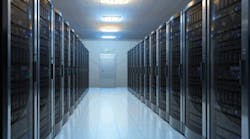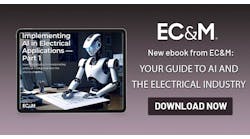The 2011 NEC and Information Technology Equipment
Information technology equipment (ITE) consumes approximately 4% of all electric power in the world. In fact, most businesses cannot exist without ITE. When it comes to working in spaces that contain this type of equipment, many electrical designers and installers have been tripped up on what Code rules apply. In 2011, the National Electrical Code (NEC) introduced some major changes for areas identified as ITE spaces per Art. 645. Key changes to be noted in this version of the NEC include:
- It is now explicitly clear that use of Art. 645 is optional.
- New terms and definitions are introduced.
- Some relaxation of building wiring requirements are permitted when certain conditions are met.
- In order to comply with the way the NEC handles requirements for communications circuits, Art. 645 distinguishes between ITE and telecommunications equipment in the same room.
- When the operations are considered “critical,” flexibility in the design of controls for disconnecting means [frequently termed emergency power off (EPO)] are permitted.
- The types of cables permitted in an ITE space are easily identified.
- Other sections of the NEC that apply to ITE are identified.
Optional use of Art. 645
Section 90.3 clearly states that Articles appearing in Chapters 5 through 7 apply to special occupancies, special equipment, or other special conditions — and are meant to supplement the general rules in Chapters 1 through 4. This distinction could have been missed in Art. 645 prior to 2011 because it stated, “This article shall applyprovided all of the following conditions are met.” A common misinterpretation of the Code (because of the use of the word “shall” was, “I see a room full of ITE stuff; therefore, the room needs to meet all of these conditions.”
The correct interpretation is that Art. 645 cannot be used unless everything on the list of conditions is met. In 2011, this ambiguity was corrected. Now the Code states, “This article shall be permitted to provide alternate wiring methods to the provisions of Chapters 1 through 4 for power wiring…” (and other identified chapters for signaling wiring and optical fiber cabling).
The list of conditions that must be met in order to apply Art. 645 was expanded in 645.4 from five to six, and is summarized as follows:
- A disconnecting means must be provided per 645.10(A) or (B).
- There must be an HVAC system dedicated to the space, or there must be smoke/fire dampers to seal the room in the event of fire.
- All of the ITE and communications equipment installed in the room must be listed.
- The room can only be occupied by, and accessible to, qualified personnel.
- The room must be separated from other occupancies by fire-resistant-rated walls, floors, and ceilings with protected openings.
- Only electrical equipment and wiring associated with the operation of the ITE can be installed.
One of the main reasons an owner would want a data center classified as an ITE space under Art. 645 is to get the relaxation permitted for certain listed under-floor power supply cables in 645.5(E). Historically, ITE spaces have been identified by a raised floor, which has been used both for cooling and for running interconnecting cables between ITE-listed power distribution units (PDUs) and IT equipment (which can be 50 ft or more away from the PDU). ITE (such as a server) is usually plugged into a listed rack-mounted power strip, which then plugs via an attachment cord into a connector or outlet box under the floor. Such boxes or enclosures can now be either metallic or nonmetallic.
Table 645.5 identifies the types of plenum, riser, and general-purpose cables permitted under raised floor, generally for signaling purposes. 645.5(E)(3) specifically permits the supply cords of listed ITE to plug into the connectors, boxes, or enclosures under the floor, even though the cords are not “plenum rated.” Per 645.5(B)(1), supply cords can be no longer than 15 ft long. In addition, 645.5(F) says the following cable types do not have to be secured in place when listed as part of, or for, IT equipment:
- Power cables
- Communications cables
- Connecting cables
- Interconnecting cables
- Associated boxes, plugs and receptacles
This gives the user a lot of flexibility in adding or removing cables.
Article 645 does not include requirements for cables that are run overhead. Power cables are typically run in cable trays. Signaling cables (including optical fiber cables) are typically run in cable trays or in cable routing assemblies. The Table (click here to see Table) identifies additional requirements for using Art. 645.
New Terms and Definitions
ITE had never actually been defined, despite being the title of Art. 645. ITE is:
- Rated 600VAC or less.
- Normally found in offices or other business establishments and similar environments.
- Used for creation and manipulation of data, voice, video, and similar signals that are not communications equipment (defined in Art. 100).
- Not used to process communications circuits (defined in 800.2).
“Zone” was used in the 2008 edition, but was not defined. A zone is “a physically identifiable area (such as barriers or separation by distance) within an ITE room, with dedicated power and cooling systems for the ITE room or systems.” The intent is to ensure the ability to remove electrical energy and prevent the spread of smoke. Some hot-aisle or cold-aisle containment systems or containerized “pods” might meet the definition.
“Remote disconnect control” was added to distinguish between the “control” (such as a push button) that had previously been required by the principal exit doors and the disconnect device itself, which might actually be in another space (such as a shunt trip operator on a feeder circuit breaker in an upstream switchboard). It is defined in 645.2 as: “An electric device and circuit that controls a disconnecting means through a relay or equivalent device.”
“Critical operations data system” is a new term introduced to explain when remote disconnecting means are not required per 645.10(B). It is ITE equipment that requires continuous operation for reasons of public safety, emergency management, national security, or business continuity. Such a determination will likely be made by an emergency management director or a similar person rather than the electrical inspector, but with the AHJ’s approval.
“Uninterruptible power supply” is usually associated with ITE and is mentioned in Art. 645. However, because the term is also used in other Articles in the NEC, it is defined in Art. 100 as a device that “provides AC power to a load for some period of time in the event of a power failure.” An informational note adds that it may also provide a more constant supply of voltage and frequency.
Abandoned cable — The 2008 NEC defined abandoned supply circuits and interconnecting cables as any that are not terminated at equipment and not identified for future use with a tag. However, 645.3(F) and (G) point to other articles that have similar restrictions for abandoned signal cables (Class 2, Class 3, and PLTC) as well as optical fiber cables and communications cables.
Cable protection — 645.5(D) requires that supply circuits and interconnecting cables, when exposed to physical damage, must be protected. For example, cables cannot be dragged over the top of other cables. Excess cable length cannot lie on the floor. Under-floor cables may be required to be run in raceway (for example, liquid-tight flexible conduit).
Disconnecting means — The requirement for, and purpose of, a disconnecting means, which is universally referred to outside of the NEC as emergency power off (EPO), has long been a contentious requirement in Art. 645, because, according to data gathered from AFCOM, the UpTime Institute, and other industry studies, it has been shown to cause almost 10 times more data center disruptions than legitimate use of the disconnecting means. Unplanned IT operations shutdown can be devastating to a business or operation. Common causes include human error, faulty wiring, deliberate sabotage, and shorts during maintenance. The purpose of a disconnecting means is to allow a firefighter to de-energize a system when there is an electrical fire. Recognizing that an unplanned loss of computer room operation could sometimes be life-threatening, 645.10 now states, “The disconnecting means shall be implemented by either (A) or (B).”
Continue to Page 2
Option A is similar to the requirements in the 2008 NEC. The newly defined remote disconnect controls “shall be located at approved locations readily accessible in case of fire to authorized personnel and emergency responders.” Each control station, which can be one or more switches, must shut down power to the ITE equipment and to the HVAC system in the entire room or in designated zones. 645.5(A)(4) permits means to prevent accidental operation. Instead of being located next to principal exits, the controls can be anywhere inside or outside of the ITE room that is acceptable to the AHJ and IT manager. One example is where controls are located in a continuously staffed security center.
Option B says that remote disconnect controls are not required for critical operations data systems, as previously defined, but additional requirements must be met:
- An approved procedure for removing power and air movement within the room or zonequalified personnel available 24/7 to meet emergency responders and advise them of disconnecting methods.
- Smoke-sensing fire detection system in place.
- Approved fire suppression system in place that is suitable for the application (i.e., electrical equipment).
- Signaling cables under the floor and exposed to airflow (i.e., not in raceway) must comply with identified sections of the Code for listed plenum cables (CL2P, CL3P, OFNP, OFCP, CMP, and CATVP).
It is still necessary to remove electrical energy to turn a class C fire into a class A fire so that it can be safely extinguished. The difference is that now it can be done in a manner that will minimize the effect on the IT operation.
The Code does not require that all electricity be removed in the IT equipment room. Equipment useful for firefighting or life safety, such as lighting systems, can remain energized, as can the feeders to the distribution equipment (e.g., PDU input feeders).
Power distribution unit (PDU) — The 2011 NEC formalized a tentative interim amendment (TIA) that had been added to the 2008 edition to allow multiple panelboards within a single cabinet. PDUs are typically listed as ITE equipment that provides branch circuit protection to multiple bays of rack-mounted modules via interconnect cables.
Engineering supervision — In a nod to the multiple levels of “design margin” typically applied to feeder circuit calculations based on equipment nameplate ratings, 645.25 now permits an engineered alternative to the load calculations required by Parts III and IV of Art. 220. Calculations can now be performed by qualified persons under engineering supervision. This alternative allows customized load calculations based on how the equipment is actually being used.
Convergence vs. Separation of IT and Communications Equipment
The definition of ITE says that it is used to create and manipulate data, voice, video, and similar signals that are not communications equipment and do not process communications circuits. Chapter 8 covers communications systems, and Art. 800 covers communications circuits.
Today, it is almost impossible to look at a piece of ITE and know what its function is. When a piece of equipment performs both IT and communications functions (for example, voice over Internet) the equipment is classified as communications equipment, and the provisions of Art. 800 apply to the signaling circuits. The power wiring is covered by Art. 645. The term “information and communications technology equipment (ICTE),” although widely used in the industry, is not recognized in the NEC. The Figure illustrates how these separate functions overlap.
Other Articles
As mentioned earlier, Art. 645 does not exclude provisions in the rest of the Code. 645.3(A) through (G) includes cross-references to other applicable sections of the code that still apply to an ITE space, including:
- penetration of the fire-resistant boundary
- ceiling cavity plenums
- grounding of optical cables
- electrical classification of data circuits
- fire alarm equipment
- communications equipment
- CATV equipment
Information technology changes at mind-boggling speed. The revisions in the 2011 NEC are the most significant to date in trying to make electrical and fire safety keep pace with the rate of technological change — and to acknowledge how deeply integrated ITE is in our daily lives.
McCluer is sr. mgr. of external codes & standards for Schneider Electric in Dallas. Kaufman is a consultant for the Communications Cable & Connectivity Association and works for CableSafe, Dunwoody, Ga. They can be reached at[email protected] and [email protected].



